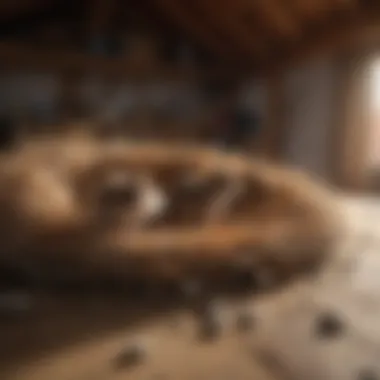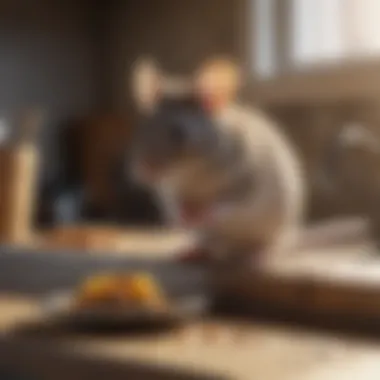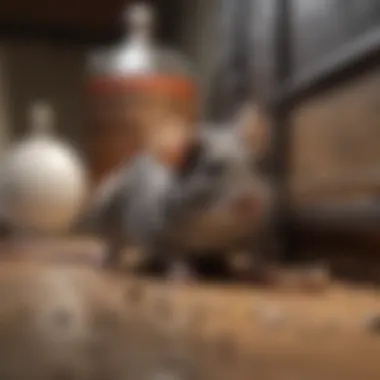Comprehensive Guide to Mice Nesting in Homes


Intro
Understanding how mice nest in residential spaces is crucial for homeowners and pest control professionals alike. Mice can adapt to various environments, making their nests in places that often go unnoticed. Knowing the specifics of where these nests are typically found can lead to effective pest management strategies. This article will delve into the nesting habits of mice, exploring their behaviors and the implications for those living in affected homes.
Understanding the Pest
Identification
Identifying a mouse infestation starts with recognizing the signs. Mice are small rodents, typically characterized by their pointed noses, large ears, and long tails. House mice, in particular, measure about 2.5 to 4 inches in body length, not including their tails. Their fur is usually gray or brown, making them blend into many environments.
Signs of mice in your home can include:
- Droppings: Small, dark pellets often found near food sources or nesting areas.
- Gnaw marks: Chewed-up materials like wood, cardboard, or wires.
- Nesting materials: Shredded paper, fabric, or insulation can be found in hidden corners.
- Nocturnal activity: Sounds during the night when mice are most active can indicate their presence.
Life Cycle
Understanding the life cycle of mice provides insight into their breeding patterns and nesting habits. Mice are rapid breeders, capable of reproducing as early as five weeks old. A female mouse can have up to 10 litters per year, with each litter containing about six to eight pups.
The life cycle stages include:
- Breeding: Females attract male mice with pheromones.
- Gestation: Pregnancy lasts about 19 to 21 days.
- Nursing: Pups are born blind and hairless, needing maternal care for about three weeks.
- Independence: Young mice become independent and can start reproducing within a month.
Understanding this cycle helps homeowners recognize the urgency in addressing infestations before they escalate.
Pest Prevention Strategies
Environment Modification
Modifying the environment can significantly reduce the likelihood of a mouse infestation. Here are meaningful steps to take:
- Seal entry points: Inspect your home for cracks and openings. Mice can squeeze through very small gaps.
- Store food properly: Use containers that mice cannot chew through, such as glass or metal.
- Clean regularly: Reduce clutter and crumbs, which can attract mice.
Implementing these modifications creates a less inviting atmosphere for mice.
Physical Barriers
Physical barriers can effectively keep mice at bay. Some strategies to consider are:
- Wire mesh: Cover vents and other openings with fine wire mesh to block access.
- Door sweeps: Install sweeps on doors to eliminate gaps at the bottom.
- Traps: Use snap traps or live traps strategically in areas where mice are active.
Protecting the home with physical barriers can help in early detection of any mice that manage to enter.
Control Methods
Chemical Control
Chemical control options for mice include various rodenticides used to reduce population numbers. While effective, caution is necessary when using these substances, especially in homes with children or pets. Follow the manufacturer's instructions strictly and consider professional assistance for safe application.
Biological Control
Biological control methods involve using natural predators or other biological agents to manage mouse populations. Introducing predators like cats or barn owls, strategically placed, can help keep mice at bay without the need for chemicals. This method promotes a natural balance while minimizing risks associated with traditional pest control methods.
Effective pest management integrates both prevention strategies and control methods, ensuring a comprehensive approach to addressing mouse infestations in residential spaces.
As we explore these nesting habits, the focus on prevention and control will prepare homeowners to address potential infestations promptly.
Preamble to Mice Nesting Habits
Understanding the nesting habits of mice is essential for homeowners. Mice tend to spread quickly, leading to infestations that can be costly and disruptive. When one comprehends where and how these animals build their nests, effective prevention measures can be put into place. This knowledge allows for a more proactive approach in managing pest control, rather than reacting to an already established problem.
By learning about mice nesting habits, homeowners can also better assess the potential health risks associated with these pests. For instance, mice can cause allergies or diseases through their droppings and urine. Furthermore, addressing nesting behavior can help mitigate property damage resulting from gnawing and contamination. Overall, delving into this topic equips homeowners with the information needed to maintain a healthy living environment.
Significance of Understanding Nesting Behavior
Recognizing the nesting behavior of mice is not merely an academic endeavor. It presents practical benefits that can safeguard your home. Understanding how mice choose nesting locations aids in implementing effective control strategies. Once homeowners identify these locations, they can make informed choices regarding sealing entry points, decluttering, and maintaining cleanliness.


Additionally, insight into nesting behavior helps tailor pest management strategies to be more effective and efficient. This understanding fosters a proactive mindset rather than a reactive one, effectively minimizing potential invasions before they escalate. Overall, the significance of grasping nesting behavior extends beyond simple prevention; it encompasses a holistic approach to home wellness.
Types of Mice Commonly Found in Homes
Mice in residential spaces vary in species, each presenting unique attributes that homeowners should understand.
House Mouse
The house mouse is perhaps the most prevalent type found within homes. Its adaptability to indoor environments makes it a common sight in urban and suburban areas alike. House mice are small, typically measuring about 2.5 to 4 inches long. They often nest in wall spaces or hidden corners, making detection difficult.
Their ability to reproduce quickly is another key characteristic. A single female can produce several litters in a year, leading to rapid population growth. This aspect underscores the importance of understanding their nesting habits, as a small problem can quickly become an infestation if not addressed early.
Field Mouse
Field mice are often found in closer proximity to gardens or fields but can easily find their way into homes. They are slightly larger than house mice, with more prominent ears and a longer body. Their nests may be located in attics or basements, especially where food sources are available.
Field mice are known to forage extensively, and they rely largely on their keen sense of smell to find food. Understanding their behavior provides advantages in preventing them from accessing residential spaces.
Deer Mouse
The deer mouse is distinguishable by its two-toned coloration and larger size. This species is often found in rural or wooded areas, but it can make its way into homes, especially in colder months.
Deer mice pose particular health risks as they are known carriers of hantavirus, which can be transmitted through their droppings. Homeowners should be vigilant regarding deer mice nesting in their spaces, emphasizing the need for thorough inspections and preventive measures.
Common Nesting Locations for Mice
Understanding the common nesting locations for mice is crucial for homeowners. This knowledge enables effective prevention and control of potential infestations. Mice typically look for safe, hidden spots that provide warmth and shelter. Awareness of these nesting sites helps in identifying and addressing problems before they escalate.
Inside Walls and Ceilings
Mice often choose the spaces within walls and ceilings for nesting. The enclosed structure offers a protective barrier from predators and environmental challenges. Furthermore, these areas can maintain a stable temperature, making them ideal for raising young. Homeowners may notice signs of infestation through sounds or scratches coming from behind walls.
Attics and Basements
Attics and basements serve as perfect habitats for mice. These areas are usually less disturbed, allowing mice to thrive unnoticed. The insulation found in attics is particularly appealing, as it provides both warmth and nesting material. Basements often contain storage items, which mice can utilize for building nests. Homeowners should regularly check these spaces for signs of mice activity, such as droppings or gnawed items.
Under Floorboards
Spaces under floorboards are another common location for mice nests. These areas are dark and secluded, offering mice a safe haven. Floorboards provide easy access to food sources above, as well as insulation. Checking under floorboards for any unusual sounds can help in identifying potential mice nesting sites.
Behind Appliances
Mice find the spaces behind appliances enticing. The warmth from the appliances, along with spilled food or crumbs, can attract mice. Ovens, refrigerators, and dishwashers are typical spots where nesting may occur due to their accessibility to food. Homeowners should regularly clean behind these appliances to reduce the likelihood of attracting rodents.
In Stored Boxes and Clutter
Cluttered areas, especially those filled with stored boxes, can easily become nesting sites for mice. Boxes offer both shelter and building materials for nesting. If left unchecked, these spots can quickly attract and house multiple mice. It is essential to maintain organized storage and conduct periodic inspections of stored items to prevent mice from taking residence.
Nesting Materials Used by Mice
Understanding the materials that mice use for nesting is crucial in grasping their behavior and the implications for homeowners. These materials provide mice with warmth, comfort, and security, allowing them to establish nests in various hiding spots throughout residential spaces. Knowing what drives their choice of nesting materials can help in effectively preventing infestations.
Common Natural Materials
Grass and Twigs
Grass and twigs are commonly utilized by mice when constructing nests. These natural materials are readily available in outdoor environments, making them an instinctive choice.
Grass fibers offer excellent insulation. Mice tend to gather dried grass and weave it into a compact structure that retains heat. This characteristic feature makes grass a practical choice for nest-building, especially during colder months. Twigs provide structural support, forming a framework within the nest.
The advantage of using grass and twigs is their natural abundance. However, one drawback is that these materials may not always be sufficient during heavy rain or humid conditions, which could compromise the integrity of the nest.
Paper and Fabric Scraps
Another common nesting material is paper and fabric scraps. Mice have a tendency to scavenge through homes for these items. Newspapers, cardboard, and old clothes can be transformed into soft bedding.


The soft nature of paper and fabric offers comfort and helps to maintain the temperature within the nest. This makes it an attractive resource for mice. Furthermore, it allows for easy transport back to their nesting area, particularly in urban settings where such items are more abundant.
However, using paper and fabric scraps can pose some issues. These materials are more susceptible to damage from moisture. If the environment is not controlled, it can lead to decaying nests, creating a potential health hazard.
Impediments to Nesting
Beyond materials, certain elements impede the nesting habits of mice. Understanding these factors can also guide preventive measures in homes.
Humidity
Humidity plays a significant role in the nesting process. Mice prefer nesting environments that have a moderate level of humidity. If humidity levels are excessively high, it may lead to mold growth, making these areas less appealing.
The key characteristic of humidity is its ability to affect material durability. When nesting materials become damp, they lose their structural integrity, which can potentially collapse the nest. This makes it an essential aspect when considering preventative actions against mice.
Temperature
Temperature is another major consideration in mice nesting behavior. Mice are warm-blooded creatures that seek out environments with stable temperatures. Extremely low or high temperatures can deter them from establishing nests in specific areas.
The primary feature of temperature is how it influences survival. When the temperature drops, mice will actively seek refuge in warmer spots, while excessively hot areas can lead to overheating.
However, when temperature conditions are suitable, it encourages nesting within homes, leading to potential infestations. Recognizing temperature as a factor can aid in implementing control strategies to keep areas unfavorable for nesting.
Behavioral Patterns Linked to Nest Building
Understanding the behavioral patterns of mice in relation to their nest building is crucial. It illuminates how these creatures not only survive but thrive within residential spaces. Their behaviors are shaped by their need for food, safety, and reproduction. Knowledge of these patterns helps homeowners identify potential risks and implement preventative measures.
Foraging and Food Storage
Mice have a strong inclination toward foraging. Their excellent sense of smell guides them to food sources. They often collect food from a wide range of sites, including kitchens, pantries, and even garbage areas. Common targets include grains, fruits, and stored human foods. By storing food close to their nests, they ensure easy access during times of scarcity. This habit can lead to significant issues for homeowners, as food storage can quickly become contaminated by droppings or urine.
The act of foraging is not random; it is strategic. Mice tend to forage during twilight hours for safety reasons. They prefer dark, sheltered places to score food. This behavior heightens the risk of infestation in less monitored areas of a home. Noticing the signs of disturbed food packages or unusual odors can indicate a mouse presence. Homeowners should be aware that mice may hoard food, further complicating the infestation.
Breeding and Rearing Young
Mice display a rapid and prolific breeding pattern. A female house mouse can give birth multiple times a year, with each litter containing an average of six to eight pups. This ability to reproduce quickly amplifies the urgency for control measures in infested areas. Mice will select nesting sites that provide safety for their young. In typical homes, this includes hidden areas within walls, attics, and basements.
The care provided to pups is essential for their survival. Female mice will build a well-insulated nest using materials gathered during foraging. This nest becomes a protective space for pups until they are mature enough to forage. If a homeowner identifies signs of a breeding pair, prompt action can prevent the establishment of a larger population.
"Understanding these behavioral patterns equips homeowners with the insight needed to take decisive action against mice infestations. Taking the right steps can significantly diminish their impact."
By recognizing the foraging habits and breeding behaviors of mice, homeowners can take preemptive actions to discourage nesting and food storage practices that attract these pests. A comprehensive understanding leads to effective pest management, safeguarding both health and property.
Impacts of Mice Nesting on Household Environments
Understanding the impacts of mice nesting is crucial for any homeowner. Mice do not just create nests; they also bring a variety of issues that affect both health and the structural integrity of a home. Recognizing these consequences helps homeowners take actionable steps to prevent infestations and mitigate existing problems.
Health Risks Associated with Mice
Allergies
Mice can significantly contribute to allergies in the household. The presence of mice leads to the accumulation of allergens such as urine, droppings, and hair. These materials become airborne, triggering allergic reactions in sensitive individuals.
This is a particularly critical point for families with children or people suffering from asthma. The key characteristic of allergy-related issues is their seemingly small impact, which can escalate to serious health concerns. Ignoring mice as potential allergens can result in long-term health implications for residents. Effective management strategies include regular cleaning, proper sealing of areas where mice may enter, and, if required, engaging pest control professionals to address infestations.
Transmission of Diseases
Mice are known vectors for various diseases that can directly impact human health. The transmission occurs primarily through contact with mouse droppings, urine, and nesting materials. Notable diseases linked to mice include hantavirus and leptospirosis. These diseases can lead to severe health complications and, in some cases, may even be life-threatening.
The unique aspect of diseases carried by mice is their silent nature. Many homeowners may not realize the problem until symptoms appear, making this knowledge vital to preventive measures. Awareness of these risks creates a necessary urgency in handling infestations before they cause health issues.
Property Damage and Contamination
Another significant impact of mice nesting is related to property damage and contamination. Mice have a tendency to chew through various materials, including electrical wiring, wood, and insulation. This can lead to costly repairs and, in some instances, poses fire hazards. Furthermore, areas where they nest are often contaminated with various pathogens.
For homeowners, this means a two-pronged approach to addressing the issue: ensuring structural integrity through preemptive maintenance and ensuring areas remain free from contaminants that can affect indoor air quality.


The presence of mice in a home not only impacts health but can also lead to substantial financial burdens down the line due to property damage.
Detecting Mice Nests
Detecting mice nests in residential spaces is essential for effective pest management. Early identification helps in minimizing health risks and property damage. Understanding how to spot these nests allows homeowners to take timely action, preventing infestations from escalating. Recognizing the signs of a mice infestation creates awareness about the potential for harm as well. It serves as both a warning to the homeowner and a guide to what steps should be taken.
Signs of an Infestation
Identifying an infestation often hinges on recognizing specific signs that indicate mouse activity. These signs can range from physical evidence like droppings to noticeable activity patterns in various parts of the house.
Chewed Materials
Chewed materials are a clear indicator of mouse activity. Mice are known for their constant gnawing. This is a necessary behavior as their teeth continually grow. They chew on a variety of materials, including wood, plastic, and cardboard.
The presence of chewed materials may suggest a nearby nest. This is because mice collect these items to build their nests. The key characteristic of chewed materials is that they are often found near nesting sites. From shredded paper to gnawed electrical wiring, any signs of chewing should be taken seriously. These materials are not only useful for nest construction but may also lead to significant damage as well. Therefore, recognizing these signs is critical for homeowners who aim to maintain a safe environment.
Droppings and Urine
Droppings and urine are also significant signs of a possible mice infestation. Mouse droppings are small, dark, and pellet-shaped, typically measuring about 1/8 to 1/4 inch in length. The distribution of droppings can point to areas where mice are active. Urine, on the other hand, can often be detected through its odor. This is a unique feature that often aids in quickly identifying infested areas.
Both droppings and urine can pose health risks. They are known carriers of various diseases. Consequently, finding either can indicate a more serious issue. Homeowners must be vigilant in checking for these signs, as they mark potential entry points to the home as well as nesting locations.
Using Traps and Monitoring
To effectively address an infestation, using traps and monitoring techniques is essential. Various trap types exist, including snap traps and electronic traps. These devices can provide insight into mice activity and help bring populations under control. Regular monitoring enhances understanding of infestation levels.
Additionally, strategic setting of traps in areas with signs of activity can yield quick results. This approach allows homeowners to actively engage in pest management, providing a proactive stance against recurring issues. By remaining observant and responsive, the path to sustaining a mouse-free environment becomes clearer.
Preventive Measures to Deter Mice Nesting
Preventing mice from nesting in residential spaces is critical for maintaining a safe and healthy living environment. Effective measures can significantly reduce the likelihood of infestations, which can lead to health risks and property damages. Implementing these strategies is not only a smart choice but also a necessary one for any homeowner.
Sealing Entry Points
One of the most important steps in deterring mice is sealing all potential entry points. Mice can squeeze through surprisingly small gaps, making it essential to inspect the home thoroughly. Common areas to check include:
- Gaps around windows and doors
- Openings around utility lines
- Cracks in the foundation or walls
Using caulk or expanding foam can effectively close these openings. Pay attention to areas where pipes and ducts enter the home; these are often neglected spots that can provide easy access for rodents. Regularly inspect and maintain these seals to ensure they remain intact.
Maintaining Cleanliness
Another vital preventive measure is maintaining a clean household. Mice are attracted to food and shelter. Thus, establishing strict cleanliness protocols will discourage them from taking up residence. Consider the following:
- Store food in airtight containers
- Regularly clean crumbs and spills
- Keep pet food sealed and stored safely
Additionally, decluttering areas like basements, attics and closets minimizes potential nesting materials. When food sources are scarce and living conditions are unattractive, mice are less likely to settle in.
Utilizing Natural Deterrents
Incorporating natural deterrents is a useful strategy for keeping mice at bay. Certain smells can repel mice and are safe for use in households with children and pets. Some examples include:
- Peppermint oil
- Cayenne pepper
- Garlic powder
Placing cotton balls soaked in peppermint oil in areas prone to mice activity can help deter them. Natural solutions provide a chemical-free approach for pest control that many homeowners appreciate.
"By addressing entry points, maintaining cleanliness, and using natural deterrents, homeowners can effectively create an unwelcoming environment for mice."
Culmination
Understanding the nesting habits of mice is crucial for maintaining a healthy and safe living environment. This article emphasizes the impact of these animals on residential spaces, focusing on both the behavioral aspects of mice and their nesting sites. The implications for homeowners are significant, especially when considering potential health risks and property damage.
Summary of Key Points
- Mice prefer to nest in hidden and inaccessible locations within homes, such as behind appliances, inside walls, and in cluttered storage areas.
- Common nesting materials, including paper and fabric scraps, are readily sourced from household waste.
- The presence of mice poses health risks due to allergies and disease transmission, necessitating awareness and proactive measures.
- Signs of infestation, such as droppings and chewed materials, serve as crucial indicators for homeowners to identify problems early.
- Preventive strategies, including sealing entry points and maintaining cleanliness, are essential in deterring future infestations.
Future Considerations
As urban environments continue to expand, understanding how mice adapt to these changes is increasingly important. Future research should focus on the evolving behavior of mice in relation to residential habits and climate conditions. Homeowners may need to adapt their pest management strategies in light of these findings.
Moreover, emphasizing community awareness and education about good practices will help mitigate infestations. Local pest control services can play a vital role in providing resources and information to residents, ensuring sustainable solutions for managing mice in homes.







